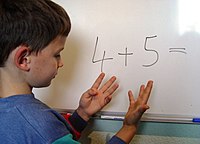
Photo from wikipedia
According to the views of social constructivism, learning takes place when individuals engage socially to talk about and act on shared problems or interests. In recent years, this approach has… Click to show full abstract
According to the views of social constructivism, learning takes place when individuals engage socially to talk about and act on shared problems or interests. In recent years, this approach has been very popular for the teaching and learning of mathematics in primary and secondary education. On the contrary, in tertiary education, it seems that most teachers still prefer the traditional way of delivering explicit mathematics instruction, sometimes combined with challenging questions and mathematical discourse with the students to promote conceptual understanding and critical analysis of the mathematical context. The paper at hand presents a classroom experiment comparing those two teaching methods at university level. The outcomes of the experiment were assessed and compared with the help of the Grade Point Average index to evaluate the student quality performance and by using grey numbers to evaluate their mean performance. Further empirical research is needed to obtain definitive results on the effectiveness of those two methods for teaching mathematics at university level.
Journal Title: Education Sciences
Year Published: 2019
Link to full text (if available)
Share on Social Media: Sign Up to like & get
recommendations!